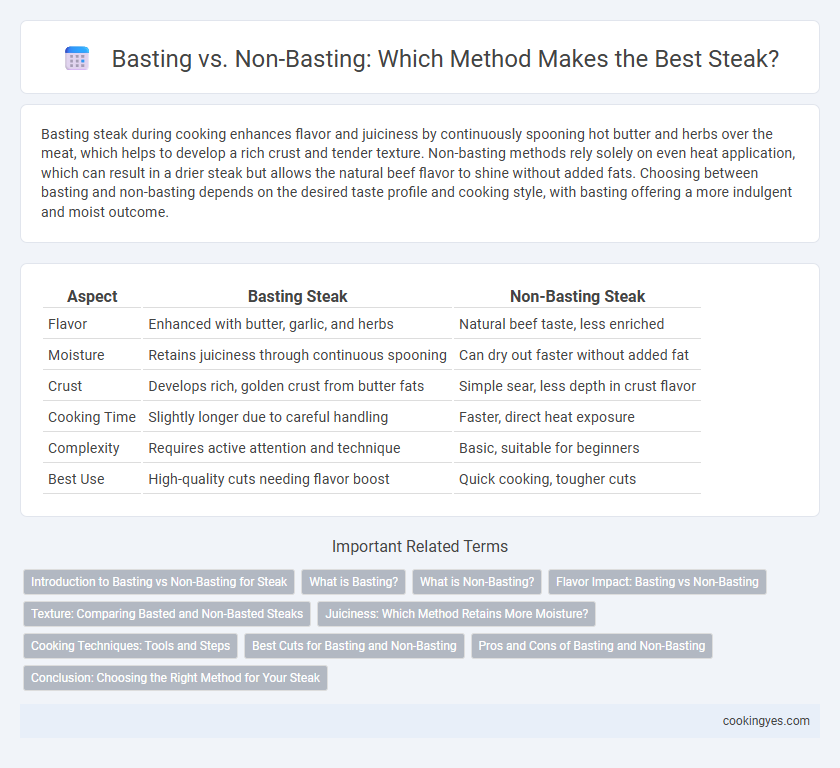Basting steak during cooking enhances flavor and juiciness by continuously spooning hot butter and herbs over the meat, which helps to develop a rich crust and tender texture. Non-basting methods rely solely on even heat application, which can result in a drier steak but allows the natural beef flavor to shine without added fats. Choosing between basting and non-basting depends on the desired taste profile and cooking style, with basting offering a more indulgent and moist outcome.
Table of Comparison
| Aspect | Basting Steak | Non-Basting Steak |
|---|---|---|
| Flavor | Enhanced with butter, garlic, and herbs | Natural beef taste, less enriched |
| Moisture | Retains juiciness through continuous spooning | Can dry out faster without added fat |
| Crust | Develops rich, golden crust from butter fats | Simple sear, less depth in crust flavor |
| Cooking Time | Slightly longer due to careful handling | Faster, direct heat exposure |
| Complexity | Requires active attention and technique | Basic, suitable for beginners |
| Best Use | High-quality cuts needing flavor boost | Quick cooking, tougher cuts |
Introduction to Basting vs Non-Basting for Steak
Basting steak involves spooning hot fat or juices over the meat during cooking to enhance flavor and moisture retention. Non-basting relies solely on the steak's natural juices and the cooking method's heat distribution to achieve doneness. Understanding the differences in texture, flavor development, and cooking control helps in choosing the best technique for desired steak results.
What is Basting?
Basting is a cooking technique where hot fat, butter, or juices are spooned over steak repeatedly during cooking to enhance moisture, flavor, and browning. This method helps to evenly distribute heat while infusing the meat with rich, savory tastes from the fats and aromatics like garlic and herbs. Basting improves the steak's texture by preventing drying out and creating a succulent, caramelized crust.
What is Non-Basting?
Non-basting steak refers to cooking the meat without continuously spooning melted butter or its juices over the surface. This method allows the steak to develop a crust naturally through dry heat, preserving its original flavors without added fats. Non-basting is often preferred for lean cuts or when a simpler, more robust beef taste is desired.
Flavor Impact: Basting vs Non-Basting
Basting steak with butter, garlic, and herbs while cooking infuses rich, aromatic flavors directly into the meat, enhancing juiciness and creating a caramelized crust. Non-basting methods rely solely on dry heat, which can result in a drier surface and less intense flavor complexity. The choice between basting and non-basting significantly influences the steak's overall taste profile and mouthfeel.
Texture: Comparing Basted and Non-Basted Steaks
Basted steaks develop a richer, more tender texture due to the continuous application of fat and juices, which enhances moisture retention and surface caramelization. Non-basted steaks often have a firmer texture with a drier crust, as they rely solely on direct heat without added lubrication. The choice between basting and non-basting significantly influences the steak's juiciness and mouthfeel, with basting promoting a more succulent bite.
Juiciness: Which Method Retains More Moisture?
Basting steak during cooking involves spooning melted butter and juices over the meat, which helps retain moisture and enhances juiciness by creating a flavorful, protective layer. Non-basting methods rely solely on the meat's natural juices, often leading to drier results due to faster evaporation and less surface moisture. Studies show basting can improve juiciness by maintaining moisture retention and preventing the steak from drying out during the cooking process.
Cooking Techniques: Tools and Steps
Basting steak involves using a spoon or brush to apply melted butter, garlic, and herbs continuously while cooking in a hot pan to enhance flavor and moisture. Non-basting relies solely on heat from the grill or pan without adding fats, focusing on natural steak juices and Maillard reaction crust formation. Essential tools for basting include a heavy skillet, a heatproof spoon, and fresh aromatics, while non-basting requires precise temperature control and often a cast-iron grill or pan to achieve even searing.
Best Cuts for Basting and Non-Basting
Ribeye and strip steaks are ideal for basting due to their marbling, which benefits from the added moisture and flavor infusion during cooking. Leaner cuts like filet mignon and sirloin are better suited for non-basting methods to preserve their natural tenderness and delicate flavor. Choosing the right cut based on basting preferences enhances the overall steak texture and taste.
Pros and Cons of Basting and Non-Basting
Basting steak enhances flavor and tenderness by continuously applying melted butter, herbs, and juices, creating a rich, moist crust, but it requires constant attention and can cause flare-ups on the grill. Non-basting allows for a more straightforward cooking process with less risk of burning, preserving the steak's natural beef flavor, though it may result in a less juicy and less flavorful exterior. Choosing basting depends on preference for enriched taste versus ease and authenticity of pure steak flavor.
Conclusion: Choosing the Right Method for Your Steak
Basting steak enhances flavor and juiciness by continuously spooning hot fat or butter over the meat, creating a rich, caramelized crust. Non-basting preserves a cleaner, more robust beef flavor with a crispier exterior by relying solely on direct heat cooking methods like grilling or broiling. Choosing between basting and non-basting depends on your desired taste profile and texture, with basting best suited for tender, buttery steaks and non-basting ideal for a bold, charred finish.
Basting vs Non-Basting for Steak Infographic

 cookingyes.com
cookingyes.com